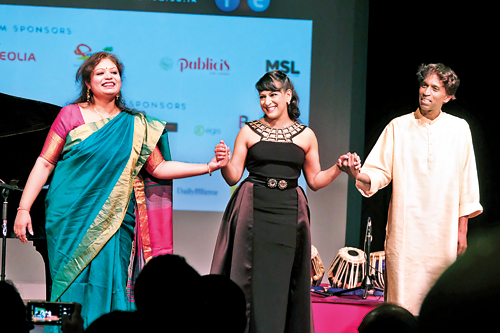Lofty synergism and bravura technique

Acknowledging the applause: Shani Diluka (centre) with Sahana and Prabhu. Pix by Amila Gamage
Three virtuoso musicians – Sahana Banerjee (sitar), Prabhu Edouard (tablas), and Shani Diluka (piano) – converged from India and France to perform as a trio at the Bishop’s College Auditorium on July 9. Banerjee is Indian while Edouard is Indo-French. Shani Diluka, who is of Sri Lankan descent, was born and raised in Monaco. Prior to its concert in Colombo, the ensemble had given six presentations of the COSMOS project – two in India, two in Bangladesh, and two in Germany.
The evening’s programme was anchored in two famous solo piano pieces – Moonlight Sonata and Appassionata Sonata – around which six ragas and selected mystical Indian verses were arranged. Now, most concert pianists would not dream of playing these two challenging Beethoven sonatas back to back. But Shani Diluka surpassed herself by performing them with aplomb. Sahana Banerjee and Prabhu Edouard were equally compelling when they performed the devotional ragas and engaged in intermittent musical dialogue with the pianist while she was playing the sonatas.
When the concert commenced, the stage was kept in darkness for an unusual length of time. Then the lights faded in with the three artists making a shadowy entrance. “From darkness to light:” this was the overarching theme, as explained by Shani Diluka (initiator of the COSMOS project) in her soul-stirring introduction. She spoke with deep conviction about Beethoven, who composed some of his greatest works (including the two above-mentioned ‘mystic’ sonatas) after he began to lose his hearing at the turn of the 19th century.
From this iconic composer’s personal notes comes the revelation that he was intimately familiar with the Upanishads – the seedbed of Indian mysticism – which were introduced to Germany in 1816. Indeed, we were honoured to hear a reading of a Brahmanic Indian poem written by the composer before the music commenced. In both of the mystic sonatas, one senses that Beethoven, who suffered from acute episodes of depression on account of his deafness, is exploring the theme “from darkness to light” from the depths of his soul.
For most of us, life is suffering. This is what Beethoven believed. He was of the view that we must constantly endeavour to develop our creative and intellectual powers so as to transcend the mundane aspects of our day-to-day existence and tap into higher cosmic forces. The mystical aspects of the COSMOS project were strongly emphasized by Shani Diluka, who believes that the creative arts transcend race, colour, creed, and national frontiers. Creative artists have a key role to play, she said, in promoting universal peace and harmony.
The COSMOS project seeks to build bridges between different cultures by demonstrating the transcendental links between Eastern and Western classical music, the former symbolized by Indian devotional ragas and the latter, by Beethoven’s mystic creations which upon close inspection, appear to have been inspired by the ragas. Just as there was a historical link between Bach and the Indian drupad genre in the 18th century, there appears to have been a similar link between Beethoven the Indian raga genre in the 19th century. The devotional ragas (we discovered) are just as divine as the mystic piano sonatas and share certain things in common, such as rhythm, flow and resonance, as demonstrated by the sitarist and the percussionist, who created bridges with the sonatas in the form of brief but sublime ‘interventions’ at critical points.
Like two musical streams originating from East and West, respectively, and merging to form a single river where the confluent tones represent universal harmony and brotherhood, both musical genres seek to transcend the chaos of mundane life and blend with the intellectual cosmos, which could broadly be defined as a noble, orderly and harmonious system of thought that possesses all the attributes of a divine order. No doubt it was with a view to creating a musical dialogue between the devotional Indian ragas and mystic Beethoven sonatas that the COSMOS project was initiated. This is groundbreaking stuff that is likely to attract global attention.
In linking Beethoven sonatas to Indian ragas, the trio succeeded eminently, though at times the dialogue was a touch bizarre. The concert surpassed all expectations with the three world-renowned musicians presenting an enthralling ‘master class.’ The ethereal aura the trio created while performing the ragas and sonatas was almost palpable. The ensemble kept the best for the last. In the frenetic ending of the Appassionata Sonata (corresponding roughly to the last two pages of the sheet music), the pianist, percussionist and sitarist combined to produce a ravishing display of lofty synergism and bravura technique.
This was an electrifying performance that transported the audience to a higher aesthetic plane. After receiving an extended standing ovation, the ensemble delivered a superb encore. Shani Diluka played Debussy’s celebrated Clair de Lune with rare clarity and then came the twist in the tail: a toe-tapping percussive ‘coda’ (never heard before) performed with great panache and elan by the trio, with the sitarist taking the lead.
To the French Embassy and the Alliance Francaise de Kotte (AFKO) we owe a debt of gratitude for bringing this extraordinary musical project to our shores, as part of the 2019 French Spring Festival.


